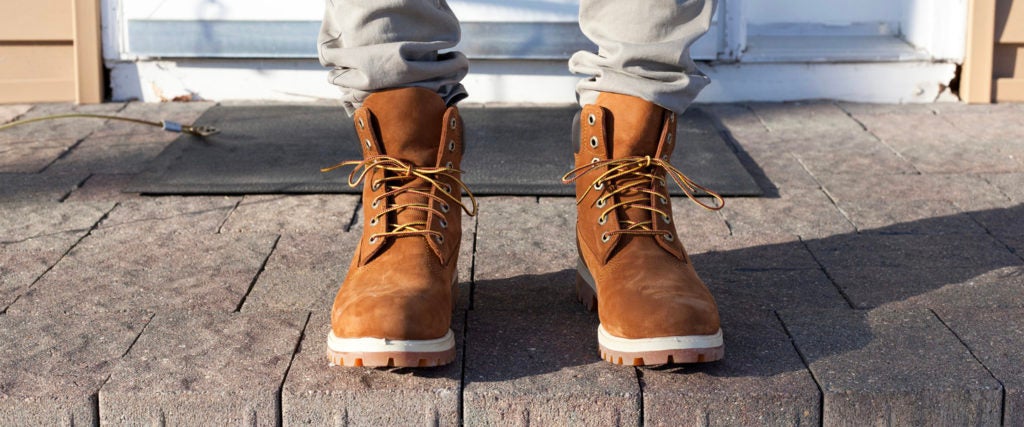I’ve always believed that you couldn’t really judge the comfort of a new pair of boots until you’ve walked at least a few miles in them. For this, I blame the salespeople selling boots — the ones who, through grinning teeth, promise that the leather will stretch and explain that boots aren’t sneakers. In other words: Boots aren’t supposed to be comfortable until mile six.
As it turns out, though, these are all lies. Boots aren’t supposed to break your toes — not even at first. That’s not to say they won’t get more comfortable as you wear them, but if you’re bleeding from your heel, or your toes feel like they’re being mutilated by the toe box at the outset, you’re being sold the wrong size or a bad pair of boots.
Boot Sizing is Different Than Shoe Sizing
Per one subscriber of r/MaleFashionAdvice (MFA), buying a pair of boots based on the foot size you think you are can be a big mistake. For example, he tells me that if you’re a size nine in most shoes, there’s a good chance your boot size is different because all leather shoes and boots are built on “lasts,” a mechanical form shaped like a human foot that’s used by shoemakers when cobbling together a boot.
Basically, a last is the model foot size that’s used to determine the size of a pair of boots. And each boot — even those made by the same manufacturer but are of a different style — can have different lasts. According to NicksBoots.com, “Think of it kind of like a bell curve; based on anatomical data, pieces of clothing or footwear can be designed to fit — let’s say — 70 percent of the human population in every shoe size.”
All of which is to say that without trying on a pair of boots, unless you’re already keenly familiar with the company’s sizing framework, there’s a good chance that if your toes are feeling cramped, you’re wearing the wrong size.
Extra Toe Room is A-okay
That’s the point (pun unavoidable), actually. As one boot aficionado notes in r/GoodYearWelt, a subreddit dedicated to quality footwear, “Excess toe room isn’t a huge concern. Under no circumstances should you size down to reduce toe room. The most important fit concerns are the flex point and heel. If the additional toe room bothers you, it may be beneficial to look for a last that offers less toe space. At minimum, there should be half an inch of toe room. Many find an inch of toe room to be preferable.”
If all that toe room bothers you, just wear thicker socks. “Not only will it increase long-term comfort, but most boot lasts are designed with thicker socks in mind,” the r/GoodYearWelt subscriber adds.
The Flex Point is the Thing
“The most important element of fit concerns the flex point of the shoe. Any sole will have a natural flex point, or point where it wants to bend,” the r/GoodYearWelt subscriber continues. “In a well-fitting shoe, the flex point of the sole lines up with the natural flex point of your foot, which should lead to creasing between the toe support and the lacing. When those flex points don’t align, your foot will slide forward or backward during your normal stride, leading to serious discomfort with long-term wear. In addition, due to excess toe-box room, it can cause the toe box to pinch down onto your toes due to the misplaced flex point.”
In short, get your flex point on point. Here’s how, says the r/GoodYearWelt subscriber: “The widest point of the shoe should approximately line up with the widest part of your foot (the ball). In addition, the heel should be moderately snug. Some heel slip is acceptable, but it shouldn’t be noticeable during your normal stride.”
Speaking of Heel Slippage…
A boot that has no heel slippage will be extremely stiff on the foot, and won’t flex with your foot when you’re walking. So again, you actually want your heel to slip a bit. What, though, constitutes “a bit”? “Maybe a quarter-inch to a half an inch at most,” says Rick Stanoff, the owner of The Country General Store who’s been selling boots for over 60 years.
A Quick Exception to the Above Rules
“Some of the Pacific Northwest true-work boot manufacturers like Whites say it can take up to 100 hours for their boots to break in,” another MFA subscriber tells me. “But these are work boots used by actual smokejumpers and whatnot.”
I’m guessing, though, your boots are not for smoke-jumping, and so, they needn’t hurt for 100 minutes, let alone 100 hours.

